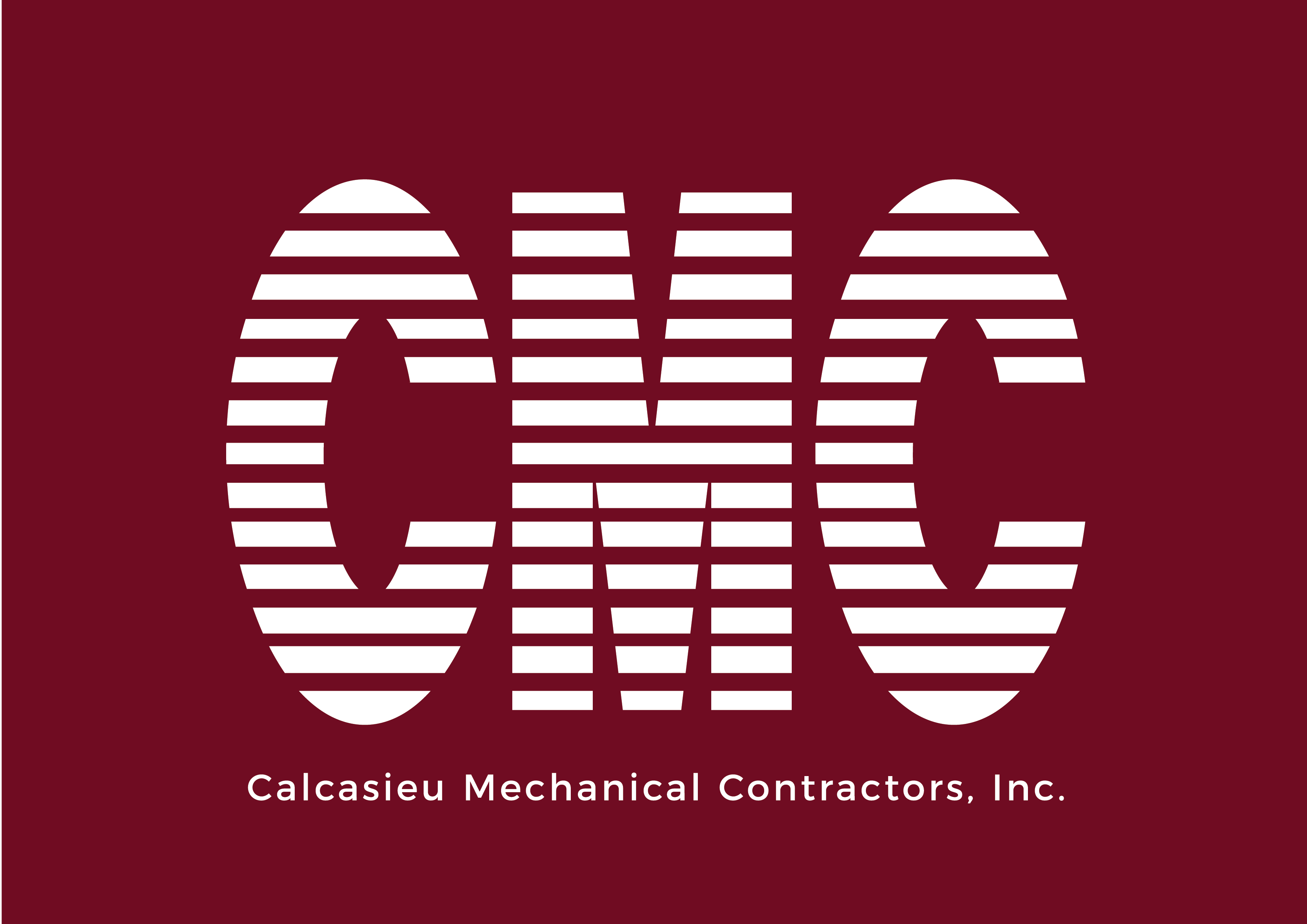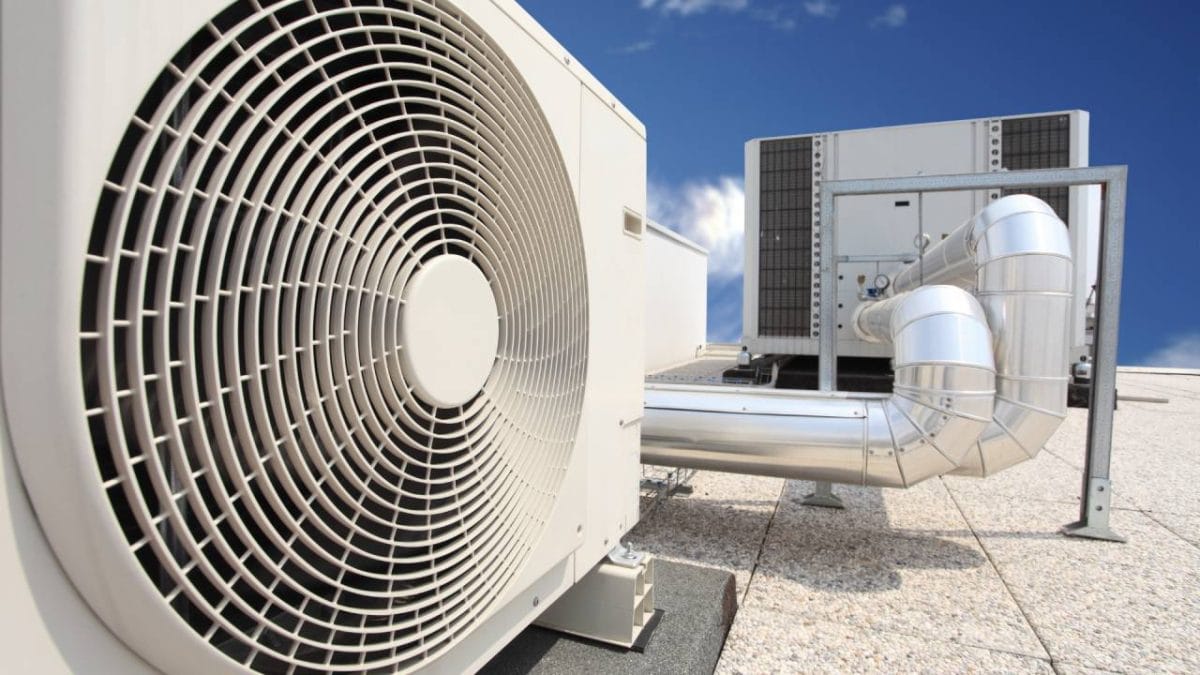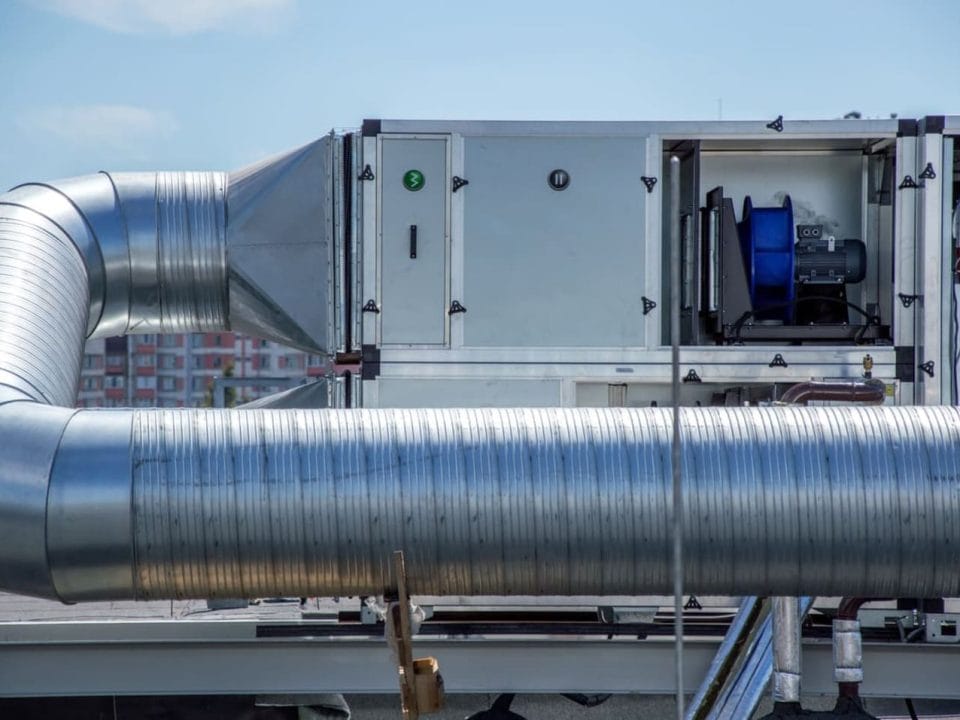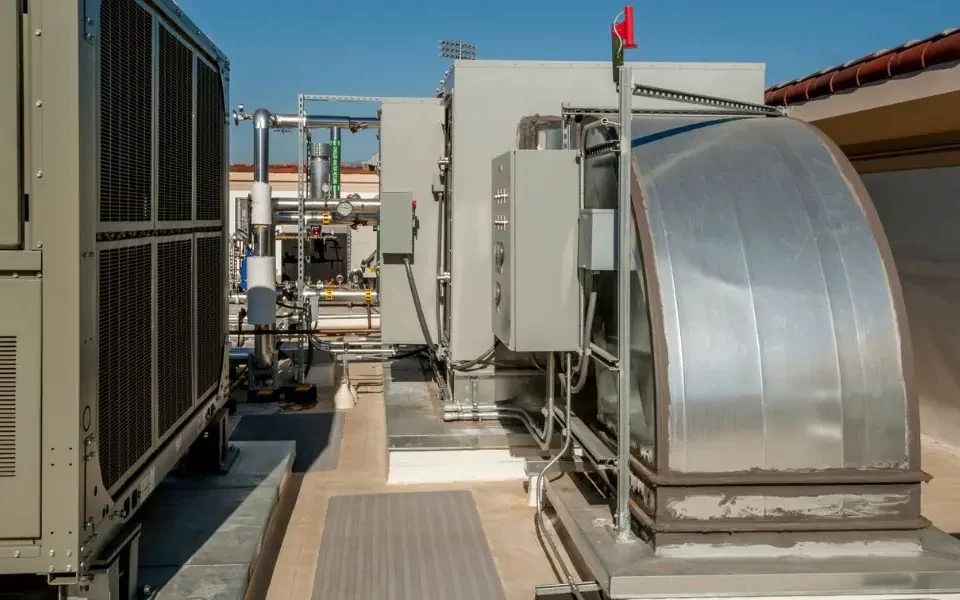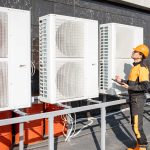
Unlocking Savings: Incentives and Grants for Energy-Efficient HVAC Upgrades
January 14, 2025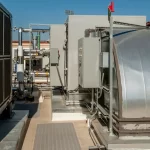
How to Improve HVAC System Efficiency in Older Buildings
May 27, 2025There’s a lot to consider when choosing the right HVAC system for your space, and understanding the differences between a rooftop HVAC unit and other systems is vital. You need to weigh factors like space efficiency, installation complexity, and energy costs to ensure optimal comfort and savings. With expertise from Calcasieu Mechanical Contractors in Lafayette, LA, this guide will help you navigate the pros and cons, empowering you to make an informed decision that best fits your home or business needs.
Key Takeaways:
- Calcasieu Mechanical Contractors highlights that rooftop HVAC units consolidate heating and cooling components in a single cabinet, offering excellent space efficiency and noise reduction, making them well-suited for commercial buildings.
- Split systems provide greater flexibility by separating indoor and outdoor components. This can lead to easier maintenance and moderate initial costs, making them suitable for residential and commercial applications.
- When choosing between rooftop units and other HVAC systems, factors such as building type, local climate, installation complexity, and long-term energy efficiency should guide the decision to ensure the most effective and economical solution.
Understanding HVAC Systems
Definition and Purpose of HVAC
Below is a concise explanation of what an HVAC system entails. HVAC stands for Heating, Ventilation, and Air Conditioning. It is designed to regulate your indoor environment by providing heating and cooling while maintaining air quality. Whether you’re managing a commercial building or your home, the system ensures comfort and a healthy atmosphere by controlling temperature, humidity, and airflow.
Key Components of HVAC Systems
Around the core of any HVAC system are several vital parts that work together to deliver comfort. These include heating elements such as furnaces, cooling units like air conditioners, ventilation ducts, and air filters. Each component plays a specific role in effectively conditioning the air within your space.
Understanding these components helps you make informed decisions when selecting or maintaining your system. For example, the furnace is responsible for heat generation, while the condenser facilitates cooling. Ventilation systems circulate fresh air and remove contaminants, contributing to healthy indoor air quality. Filters are your first line of defense against airborne particles, making their upkeep vital to avoid system inefficiency and health risks.
Importance of HVAC in Modern Buildings
Understanding the value of HVAC systems is key in today’s building design. These systems contribute significantly to occupant comfort, energy savings, and air quality management. Choosing the right HVAC solution tailored to your building’s needs enhances functionality and operational efficiency.
The role of HVAC extends beyond comfort; it directly impacts the longevity of your building’s infrastructure and your well-being. Poorly maintained or improperly selected systems can lead to increased energy consumption and higher utility costs, while also raising the risk of airborne pollutants affecting health. With Calcasieu Mechanical Contractors’ expertise, you can ensure your system supports sustainable and safe indoor environments.
Overview of Rooftop HVAC Units
Definition and Characteristics
With rooftop HVAC units, you get an all-in-one system that houses heating, ventilation, and air conditioning components in a single cabinet mounted on your building’s roof. This design optimizes indoor space while reducing noise inside your premises. These units are known for their compact footprint and integrative approach to climate control, making them a popular choice in commercial building applications.
Common Applications
Before selecting a rooftop HVAC unit for your project, it’s important to understand where these systems are most effective. They are widely utilized in commercial settings such as office buildings, retail stores, and industrial facilities, where the top priorities are saving indoor space and minimizing operational noise.
Units from Calcasieu Mechanical Contractors are designed to deliver efficient climate control, particularly in commercial environments requiring robust performance and streamlined installation. Their ability to consolidate components reduces maintenance complexity and supports easier roof access for repairs, helping keep operations running smoothly.
Types of Rooftop HVAC Units
Characteristics of rooftop HVAC units vary depending on system design and capacity. Here’s a concise comparison to help you identify the most suitable option for your needs:
| Unit Type | Key Features |
| Packaged Unit | All components integrated; easy installation and service access |
| Split Rooftop Unit | Separated indoor/outdoor units; flexible configuration |
| Variable Refrigerant Flow (VRF) | Energy-efficient, zone-specific control |
| Heat Pump Rooftop Unit | Provides both heating and cooling, energy-saving |
| Electric Rooftop Unit | Ideal for areas without natural gas access, a clean energy source |
This variety ensures you can tailor your HVAC system to the specific demands of your building, enhancing energy efficiency and overall comfort. Perceiving the differences between these units will help you make an informed choice that best supports your property’s needs.
- Packaged Units: Streamlined installation and maintenance
- Split Units: Enhanced flexibility and zoning options
- VRF Systems: Superior energy efficiency and comfort control
- Heat Pumps: A cost-effective heating and cooling solution
- Electric Units: Environmentally friendly and versatile
Benefits of Rooftop HVAC Units
Once again, choosing a rooftop HVAC unit brings several distinct advantages that can significantly impact your building’s functionality and comfort. These units integrate all heating and cooling components into a single rooftop cabinet, offering benefits beyond traditional systems. Understanding these perks lets you decide if a rooftop unit aligns with your building’s needs and design priorities.
Space-Saving Advantages
After installing a rooftop HVAC unit, you free up valuable indoor and ground-level space that bulky equipment would otherwise occupy. This is especially beneficial in commercial settings where floor space is at a premium. Elevating your HVAC system to the roof also maintains a cleaner, more flexible interior layout for your operations or tenants.
Energy Efficiency
Above all, rooftop HVAC units are designed to optimize energy consumption across heating and cooling cycles. These all-in-one systems reduce energy loss by limiting the distance air and refrigerant travel, unlike split systems, where components are separated. This can contribute to lower utility bills and a more sustainable building operation.
The advanced components integrated within rooftop units, such as high-efficiency compressors and smart controls, further amplify energy savings benefits. When you work with experienced providers like Calcasieu Mechanical Contractors, you ensure your system is properly calibrated for peak performance, enhancing efficiency and reducing your environmental impact.
Reduced Noise Pollution
Units installed on rooftops naturally minimize indoor noise disturbances by distancing noisy components away from occupant areas. This arrangement helps you maintain a quieter, more productive environment inside your building.
Another advantage is that rooftop placement prevents the transmission of mechanical sounds through walls and floors, which can be a concern with indoor or ground-level units. This noise reduction improves occupant comfort without requiring additional soundproofing measures, allowing you to focus budget and effort on other building improvements.
Installation Considerations for Rooftop Units
Despite their many advantages, installing rooftop HVAC units requires careful planning and expertise to ensure your building can support the system safely and operate efficiently. Choosing the right professionals, like Calcasieu Mechanical Contractors, will help you navigate these important aspects effectively.
Structural Requirements
At the core of installing a rooftop HVAC unit is the need for adequate structural support. The roof must be reinforced to handle the significant weight of the unit and withstand environmental factors such as wind and seismic forces. Failure could lead to costly damage or safety hazards if your building’s structure is not designed to carry this load. Working with Calcasieu Mechanical Contractors ensures this concern is addressed with precision.
Accessibility and Maintenance
Regular maintenance is necessary throughout your rooftop unit’s lifespan to keep it operating efficiently and extend its lifespan. You should plan for safe and convenient access routes for technicians, which can involve ladders, walkways, or platforms. This reduces downtime and minimizes risks associated with service tasks.
Structural design also impacts maintenance ease; if access paths are too narrow or obstructed, servicing your unit can become complicated and costly over time. Proper planning during installation by Calcasieu Mechanical Contractors can optimize these elements, enhancing safety and lowering maintenance expenses.
Local Building Codes and Regulations
Between various municipal and state regulations, installing rooftop HVAC units demands strict compliance. Depending on your location, your project must conform to safety codes, energy efficiency standards, and environmental restrictions.
Engaging contractors like Calcasieu Mechanical Contractors, who are well-versed in Lafayette, LA, local codes, is necessary. This expertise ensures your installation meets all legal requirements to avoid fines, delays, or forced modifications, safeguarding your investment and peace of mind.
Overview of Split HVAC Systems
Understanding split HVAC systems is crucial when deciding on the best setup for your space. These systems separate heating and cooling components, providing flexibility and efficient temperature control that fits both residential and commercial needs.
Components of Split Systems
On a split system, the primary components include an outdoor condenser unit and an indoor air handler or furnace. These parts work together through refrigerant lines to regulate the temperature within your building effectively, allowing you to enjoy consistent comfort without extensive indoor machinery.
Configuration and Design Options
For your HVAC needs, split systems offer various configurations such as single-zone or multi-zone setups. This versatility lets you tailor your system precisely, optimizing energy use and comfort room by room according to your specific requirements.
Components like inverter-driven compressors and smart thermostats enhance these options further, giving you greater control over energy consumption and indoor climate. This flexibility ensures your system can adapt as your building or comfort needs evolve.
Common Applications
Options for split systems suit a broad range of environments, from single-family homes to small and medium-sized commercial buildings. Their design efficiency often makes them a top choice when space constraints or noise concerns are factors you’re managing.
For instance, Calcasieu Mechanical Contractors in Lafayette, LA, effectively leverages split systems in varied projects, balancing installation ease and performance. Whether upgrading existing systems or installing from scratch, these HVAC units deliver reliable, energy-efficient operation tailored to your setting.
Advantages of Split HVAC Systems
Not all HVAC systems require rooftop placement, making split systems a popular choice for many building types due to their versatile design. These systems efficiently separate indoor and outdoor components, giving you more control over installation and maintenance while ensuring reliable performance.
Flexibility in Installation
HVAC split systems offer significant flexibility in installation since the indoor and outdoor units can be placed in different locations to suit your building’s layout. This allows you to optimize space and noise levels effectively, making split systems an excellent fit for both residential and commercial applications.
Zoning Capabilities
With zoning capabilities, split HVAC systems allow you to independently control temperatures in different areas, enhancing comfort and energy savings. This feature is ideal if your space has varying heating and cooling needs, enabling tailored climate control without extra energy waste.
Even more, zoning capabilities can improve overall system efficiency by preventing unnecessary heating or cooling in unoccupied zones. This thoughtful control reduces utility bills and extends equipment lifespan, making split systems a smart long-term investment.
Energy Efficiency
An energy-efficient split system helps you reduce your carbon footprint while lowering operational costs. These systems typically use inverter technology and advanced thermostats, enabling precise climate control that maximizes energy usage without compromising comfort.
Split systems reduce energy losses and improve system responsiveness due to their design, separating indoor air handlers from outdoor compressors. When you work with Calcasieu Mechanical Contractors, you can expect expert installation that leverages these efficiency features, ensuring that your HVAC setup is optimized for your specific needs in Lafayette, LA.
Furnace and Condenser Systems Explained
Basic Functionality of Furnaces
After understanding the broader HVAC options, it’s crucial to grasp the role of furnaces in your system. Condenser units and furnaces work together to regulate your indoor climate effectively. Your furnace primarily focuses on heating by burning fuel or using electric elements to generate warmth, which is then distributed throughout your home. This system ensures you stay comfortable during colder months and is designed to operate safely within your existing infrastructure.
Role of Condensers in HVAC
Condensers are integral to your HVAC system’s cooling cycle. They expel the heat absorbed from inside your home to the outdoors, working in tandem with the furnace during the warmer months. Understanding the condenser’s function helps you optimize your system for energy efficiency and longevity, especially in climates demanding reliable cooling capabilities.
The role of condensers extends beyond mere heat expulsion. They compress refrigerant gases, facilitating the exchange of heat that cools your living space. Efficient condenser operation directly impacts your utility bills and system lifespan, so ensuring proper maintenance and installation through trusted professionals like Calcasieu Mechanical Contractors is vital for optimal results.
Types of Furnaces and Condensers
Alongside your HVAC choices, you can select from various furnaces and condensers depending on your building’s requirements and budget. Here’s a quick overview:
| Type | Description |
|---|---|
| Gas Furnace | It uses natural gas for heating and is popular for efficiency and cost-effectiveness. |
| Electric Furnace | Heats air via electric elements; ideal for homes without gas access. |
| Single-Stage Condenser | Operates at full capacity; simple but less energy efficient. |
| Two-Stage Condenser | It offers variable cooling levels and is more efficient and comfortable. |
| Variable-Speed Condenser | Adjusts output precisely; maximizes efficiency and reduces noise. |
Further, you should consider the maintenance requirements and long-term energy savings when choosing your furnace and condenser.
- Gas furnaces tend to offer quicker heating but require regular inspections.
- Electric furnaces provide safer operation without fuel combustion.
- Single-stage condensers are cost-effective upfront, but can increase energy costs.
- Two-stage and variable-speed condensers deliver enhanced comfort and efficiency.
- The right combination of furnace and condenser maximizes performance while aligning with your budget.
Comparing Rooftop Units to Split Systems
All HVAC options have unique advantages and challenges, especially when comparing rooftop units to split systems. Understanding how each performs in key areas will help you select the best fit for your building’s needs.
Space Efficiency
After evaluating your space requirements, you’ll find that rooftop units excel in saving valuable indoor square footage since they are installed on the roof, freeing up areas inside your building. On the other hand, split systems require dedicated indoor space for their air handlers, which may limit your interior layout options if space is tight.
Installation and Maintenance Considerations
In terms of the installation process, rooftop units often demand significant structural support and professional expertise to handle the weight and roof placement safely. Split systems are generally easier to install with less structural modification, but can present maintenance complexities due to separated components.
At Calcasieu Mechanical Contractors, we understand that rooftop units require reinforced roofing and specialized equipment for installation, which can increase upfront costs and time. However, their all-in-one design simplifies routine maintenance once installed. In contrast, split systems involve servicing components across different locations—indoor and outdoor—potentially increasing maintenance visits but offering easier access without roof work.
Energy Efficiency and Performance
Any decision on HVAC should weigh energy efficiency heavily. Rooftop units provide integrated systems that can be optimized for commercial buildings, facilitating better energy management. Conversely, split systems offer flexibility in capacity and can be more energy-efficient in residential or smaller commercial setups.
Even though rooftop units consolidate heating and cooling elements, maintenance lapses due to difficult access can negatively impact performance. Split systems, by separating components, allow you to address specific system parts quickly, which helps maintain efficiency over time. Trust Calcasieu Mechanical Contractors to advise on the best system tailored to your energy goals and building environment.
| Rooftop HVAC Units | Split Systems |
|---|---|
| Located on the roof, preserving indoor space | Components are split between indoor and outdoor units, requiring indoor space |
| Requires structural reinforcement and professional installation | Easier installation, but maintenance is spread across different locations |
| Integrated system simplifies ongoing maintenance | Separated components may mean more complex maintenance visits |
| Optimized for commercial buildings with energy-efficient options | Flexible capacity suitable for residential and small commercial applications |
Cost Considerations in HVAC Systems
Initial Installation Costs
Below the surface, initial installation costs can vary significantly depending on your chosen HVAC system. Rooftop HVAC units often require structural reinforcing to support their weight on your building’s roof, which can increase upfront expenses. In contrast, split systems and furnace condenser setups tend to have lower installation complexity, making them potentially less costly initially. When working with Calcasieu Mechanical Contractors, you can expect transparent pricing that reflects these differences, helping you make an informed choice that aligns with your budget.
Long-term Operating Costs
After installation, your HVAC system’s long-term operating costs become significant. Rooftop units may offer benefits like noise reduction and consolidated components, but maintaining their efficiency can sometimes involve higher service costs, especially in harsher climates. Split systems generally allow easier maintenance and component replacement, which may reduce your ongoing expenses over time. By partnering with Calcasieu Mechanical Contractors, you ensure professional upkeep that optimizes your system’s performance and energy use.
While energy efficiency goals should guide your choice, consider how system design impacts your utility bills. Rooftop units might initially use more energy due to their all-in-one setup, but this can be balanced by efficient modern technology. Split systems, given their flexibility, can target specific zones and potentially reduce wasteful energy consumption. Your choice directly affects your long-term savings and environmental impact.
Return on Investment Analysis
Understanding the return on investment (ROI) across different HVAC options is vital. Rooftop units often excel in commercial applications by maximizing space and minimizing noise, which can increase property value and operational efficiency. Alternatively, split systems offer flexibility and potentially lower upfront costs, but you should evaluate these benefits against your specific needs. Calcasieu Mechanical Contractors can provide a tailored ROI analysis based on your building type, local climate, and energy goals.
Another aspect to consider is the system’s lifecycle. Rooftop HVAC units, though sometimes costlier in maintenance, typically have a robust lifespan that can offset early expenses. Split and furnace condenser systems may require more frequent replacements or upgrades, impacting your overall investment. Balancing initial costs with long-term value will help you choose an HVAC solution that meets your financial and comfort objectives.
Decision Factors for Choosing HVAC Systems
To select the right HVAC system, you must weigh several key factors directly impacting performance, cost, and longevity. Consider:
- Climate and environmental impacts
- Type and design of the building
- Future expansion and adaptability
- Installation and maintenance requirements
- Energy efficiency goals
Recognizing these elements will help you make a well-informed decision that meets your needs and optimizes your investment.
Climate and Environmental Impacts
Choosing your HVAC system based on local climate conditions ensures optimal energy efficiency and comfort. In areas like Lafayette, LA, where humidity and heat are significant, systems from Calcasieu Mechanical Contractors designed to handle such environments provide better durability and performance. Adapting to environmental factors helps you avoid unnecessary wear and reduces your energy bills.
Type and Design of Building
After evaluating your building’s size and layout, your HVAC choice should align with structural and spatial considerations. For instance, commercial buildings often benefit from rooftop units for space-saving, while residential homes may prefer split systems for flexibility.
Understanding your building’s design helps you plan installations that reduce noise pollution and optimize indoor air quality, ensuring a more comfortable environment.
Future Expansion and Adaptability
Design your HVAC system with potential growth in mind. Scalability and adaptability mean you’ll avoid costly replacements when your space or needs change.
Further, systems from Calcasieu Mechanical Contractors offer modular options, allowing for easy upgrades or expansions without disrupting existing infrastructure. This gives you long-term cost savings and flexibility.
Regional Preferences and Trends
Geographic Considerations in HVAC Choice
Below, your choice of HVAC system should align with your location’s specific climate and environmental conditions. For instance, regions with hot, humid weather may benefit from rooftop HVAC units’ space efficiency and noise reduction, while areas with milder temperatures might find split systems more flexible. By factoring in local weather patterns, you ensure better performance and energy savings tailored to your building’s needs.
Industry Standards and Practices
Considerations of local building codes, safety regulations, and energy efficiency standards play a significant role in deciding on your HVAC system. Your installation must comply with these standards to avoid costly adjustments and maintain system longevity. Aligning with regional practices ensures smooth inspection approvals and optimized operation tailored to local requirements.
Considering industry standards and practices in your area means engaging professionals familiar with both installation and maintenance protocols required by local authorities. This ensures compliance and leverages tested methods for enhancing system reliability and efficiency. By trusting experts like Calcasieu Mechanical Contractors, you gain access to a team knowledgeable in regional mandates and equipped to deliver HVAC solutions that meet your unique demands.
Case Studies from Different Regions
With diverse climates impacting HVAC performance, several regions demonstrate how tailored system choices lead to optimal outcomes:
- Montreal: Implementation of split systems led to a 15% energy reduction in residential buildings due to efficient heating adaptations.
- South Florida: Rooftop HVAC units proved effective in noise reduction and space savings for commercial spaces, significantly improving occupant comfort.
- Lafayette, LA: Calcasieu Mechanical Contractors upgraded furnace and condenser systems, achieving 20% higher energy efficiency in mixed-use buildings.
These case studies also show that adapting HVAC choices enhances comfort and drives down operational costs. The examples emphasize how regional expertise, like that of Calcasieu Mechanical Contractors in Lafayette, LA, can tailor HVAC solutions that fit local climate dynamics and regulatory environments, guaranteeing both compliance and performance.
Special Considerations in HVAC Selection
Many factors influence the choice of your HVAC system beyond basic functionality. When choosing between rooftop HVAC units and other systems like split or furnace condenser setups, evaluating specific building needs, environmental conditions, and long-term goals is important. Considering these special aspects ensures your HVAC system delivers optimal performance, comfort, and efficiency for your unique situation.
Indoor Air Quality Requirements
Above all, maintaining high indoor air quality is important for your health and comfort. Some HVAC systems provide enhanced filtration and ventilation options to effectively reduce allergens and pollutants. Depending on your building type and occupant sensitivities, you might prioritize systems that integrate advanced air purification to support a cleaner and healthier indoor environment.
Noise Level Expectations
The selection of an HVAC system must consider the acceptable noise levels for your space. Rooftop units typically operate quietly indoors since the equipment is placed externally, which can be advantageous for workplaces or residential areas requiring minimal sound disturbance.
For instance, noise can disrupt productivity or patient comfort in office buildings or healthcare facilities. By choosing a rooftop HVAC unit installed by Calcasieu Mechanical Contractors, you can benefit from reduced indoor noise compared to some split or furnace condenser systems that place equipment closer to living or working areas.
Compliance with Energy Standards
Among many decision points, ensuring your HVAC system meets current energy standards is vital. Energy-efficient systems help you control operational costs and lessen environmental impact. You should select equipment that aligns with or surpasses local regulations to maximize savings and sustainability.
Understanding the latest energy codes and efficiency ratings helps you make informed choices when working with Calcasieu Mechanical Contractors. Systems like rooftop HVAC units often offer competitive energy efficiency, but balancing this with installation and maintenance needs will guide you toward the most effective solution for your budget and building design.
Maintenance and Longevity of HVAC Systems
Routine Maintenance Needs
Maintenance is imperative to keep your HVAC system running smoothly and efficiently. Regular tasks such as cleaning or replacing filters, checking refrigerant levels, and inspecting electrical connections help prevent unexpected breakdowns. For systems like rooftop units or split systems, scheduling professional inspections at least twice a year ensures optimal performance and energy efficiency, extending the system’s lifespan while saving you money on costly repairs.
Signs of System Wear and Tear
Below are common indicators that your HVAC system may be experiencing wear and tear: unusual noises, inconsistent temperatures, increased energy bills, and frequent cycling on and off. Spotting these signs early allows you to address potential problems before they become serious, helping maintain comfort and reduce repair expenses.
A well-maintained HVAC system may still show wear and tear over time due to environmental factors, usage intensity, and age. Components like compressors, fans, or heat exchangers might degrade, causing reduced efficiency or system failures. Being attentive to these symptoms and consulting with experts at Calcasieu Mechanical Contractors can help you decide whether repair or replacement is the best course of action to protect your investment.
Lifespan Expectations for Different Systems
With proper maintenance, rooftop HVAC units typically last around 15 to 20 years, while split systems, furnaces, and condenser setups can last between 10 and 25 years, depending on usage and care. Understanding these timelines helps you plan for timely upgrades and budget accordingly.
Wear from daily operation, weather exposure, and component fatigue gradually impacts performance. Neglecting maintenance can significantly shorten an HVAC system’s life, leading to increased breakdowns and higher energy usage. Partnering with Calcasieu Mechanical Contractors ensures your system remains in top condition, maximizing both lifespan and efficiency.
To wrap up
Hence, when choosing between rooftop HVAC units and other HVAC systems, you must weigh the pros and cons based on your space, budget, and specific requirements. Rooftop units save indoor space and reduce noise, making them ideal for commercial buildings. At the same time, split systems and furnace condenser setups offer greater flexibility and often lower initial costs, fitting a variety of applications. By consulting Calcasieu Mechanical Contractors in Lafayette, LA, you can ensure that your HVAC choice aligns with your energy efficiency goals and operational needs, resulting in a comfortable and effective indoor environment tailored to you.
FAQ
Q: What are the main advantages of rooftop HVAC units over other HVAC systems?
A: Rooftop HVAC units provide excellent space efficiency by consolidating all heating and cooling components into a single unit installed on the roof, which frees up indoor space. Since the equipment is located outside the occupied area, it produces less indoor noise. Additionally, rooftop units can simplify maintenance by having all components accessible in one place. However, installation requires ensuring the building’s roof can support the unit’s weight, which is a key consideration handled by professional contractors like Calcasieu Mechanical Contractors.
Q: How do split HVAC systems compare to rooftop units in terms of energy efficiency and cost?
A: Split systems separate indoor and outdoor components, allowing more flexibility in installation and often providing improved energy efficiency through better zoning and control options. Typically, split systems have a moderate initial cost compared to rooftop units, which may demand a higher upfront investment due to structural modifications and installation complexities. Over time, split systems can offer savings through targeted heating and cooling, while rooftop units might benefit larger commercial spaces where centralized control is preferred. Calcasieu Mechanical Contractors can help evaluate which system fits your needs and budget.
Q: What factors should be considered when choosing between rooftop HVAC units and furnace/condenser systems?
A: Key factors include the building type, available installation space, climate, and maintenance preferences. Rooftop HVAC units work well for commercial buildings where roof space is accessible and noise reduction is a priority. Furnace and condenser systems are commonly used in residential or smaller commercial spaces and can provide separate heating and cooling functions that may allow for easier repairs or upgrades. Local climate conditions and future expansion plans are also important; Calcasieu Mechanical Contractors offers tailored consultations to help Lafayette, LA, customers make informed decisions based on these factors.

Hailing from the picturesque town of Lake Charles, Louisiana, Jim Blanchard stands as an exemplar in commercial HVAC installation and services. As President of Calcasieu Mechanical, he has leveraged his deep industry knowledge and innovative strategies to establish the company as a leading regional service provider. Under Jim’s leadership, Calcasieu Mechanical has expanded its portfolio of high-quality services and earned the trust and respect of businesses throughout Louisiana. The company’s commitment to excellence, reflected in its endeavors, stems from Jim’s dedication to ensuring every project meets and exceeds client expectations.
